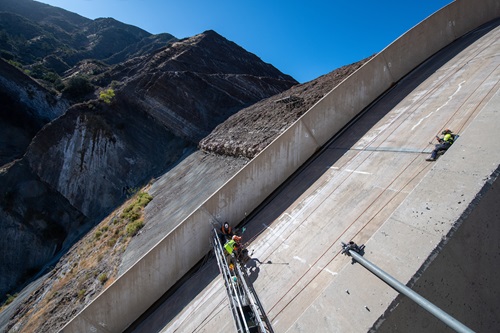Pyramid Dam and Lake are located about 60 miles northwest of downtown Los Angeles and provides water storage for the greater Los Angeles area. The dam was built between 1969 and 1973 as part of the California Department of Water Resources (DWR) State Water Project (SWP).
DWR is modernizing its SWP portfolio across the state. This includes identifying and proactively addressing any issues that could impact the delivery of water or the safety of surrounding communities. Over the next several years, DWR will conduct assessments of Pyramid Dam and undertake measures to ensure the dam continues to function safely.
Status of Pyramid Dam
In its most recent condition assessment, the California Division of Safety of Dams (DSOD) rated Pyramid Dam as Fair – meaning there are no existing dam safety deficiencies recognized for normal operating conditions. However, rare or extreme hydrologic and/or seismic events may result in a dam safety deficiency. Interim or permanent risk reduction measures may be under consideration. In the case of Pyramid Dam, the rating of Fair is due to the concern over performance of the unlined emergency spillway during an extreme flood. The emergency spillway has never experienced water flow, as DWR has successfully managed reservoir levels over the years and released flood inflows through the low-level outlet and the gated spillway. An example of an interim measure that DWR continues to implement is operating the reservoir at a lower level during the winter to reduce the risk associated with large spillway releases.
Based on the most recent DSOD findings as well as other inspection and assessment activities conducted by DWR’s Division of Operations and Maintenance, the initial focus of the Pyramid Dam Modernization Program has been to assess the impacts of an extreme weather event on the gated spillway and the emergency spillway.
Spillways Condition and Extreme Weather Assessments
- The gated spillway at Pyramid Dam is used approximately once per year to release natural inflows and whenever inflows exceed stream release capacity.
- The emergency spillway at Pyramid dam has never been used.
- Climate models show that increased temperatures in California will result in more precipitation falling as rain instead of snow which will change river flows in the state and could impact how DWR operates the SWP facilities to manage changing precipitation patterns.
- DWR wants to ensure that the gated spillway will continue to work and that the emergency spillway will work appropriately if some future events require its use.
- The gated and emergency spillway assessments and field investigations that began in September 2019 were completed in March 2020. DWR engineers, geologists, and consultants assessed the 860-foot-long gated and 900-foot-long emergency spillways at Pyramid Dam by climbing a combined 530 miles and performing 450 helicopter flights in nearly 200 project days. The investigation included 25 drilled core holes on the gated spillway to verify the slab thickness and 41 drilled core holes on the emergency spillway to obtain characterization of the rock composition for the emergency spillway and the left and right abutments of the dam. Data reports from these investigations were completed in 2021 and 2022.
- The gated spillway investigation’s findings have led to maintenance actions and improvements in the routine inspection, surveillance, and monitoring of the spillway.
- Erodibility analyses completed in 2020 for the unlined emergency spillway indicate that while erosion and damage to the spillway may occur, the potential for erosion to headcut back to the spillway weir and reservoir is remote, even under extreme flow conditions. In 2025, DWR initiated work on a more advanced erodibility analysis that considers the time-rate of scour to better understand the extent of erosion that could occur under a range of flows. This work is anticipated to better guide any needed armoring of the emergency spillway.
- DWR continues to implement a winter operations plan that lowers the reservoir level between December and March to reduce the likelihood of emergency spillway use.
- DWR has been working with Southern California Edison to design and install a stand-alone power source for Pyramid Dam that will not be subject to loss of power due to high wind events, wildfires, or public safety power shutdowns. Construction is expected to begin in 2025.
Earthquake Resiliency Assessments
- In 2019, DWR completed an analysis of the expected performance of the intake towers (the structures that are used release water from the reservoir) in the event of an earthquake. Damage to the towers during an earthquake would not cause the dam to fail, however they may significantly reduce DWR’s ability to release water, slowing/reducing the delivery of water to customers. If this occurred during peak water inflow to the reservoir (typically late winter and early spring), the reduced ability to release water could raise reservoir levels too much, and DWR would potentially have to use the emergency spillway to release water and lower water to a safe level. The winter operations plan reduces the risk associated with this combination of extreme weather and a seismic event.
- DWR recently completed seismic evaluations of the gated spillway to determine its performance under a major earthquake. The evaluations confirmed that retrofits to both the radial gate and its headworks structure could significantly improve their seismic resiliency. DWR continues to study alternatives that will best improve the gated spillway’s seismic resiliency.
Project Updates and Timeline:
- In 2020-2021, DWR conducted a pilot Periodic Risk Analysis (PRA) for Pyramid Dam in alignment with Federal Energy Regulatory Commission Draft Engineering Guidelines for a semiquantitative “Level 2” risk analysis. This effort aligned with DWR’s transition to risk-informed decision making for investments in the SWP.
- In fall of 2022, DWR initiated the Pyramid Dam Safety Assessment which is leveraging the investigations and studies performed over the past few years to examine, evaluate, and prioritize potential vulnerabilities to the facility and identify potential risk reductions measures that DWR may consider implementing as part of its overall risk management of the SWP. DWR will incorporate the potential failure modes identified in the Pyramid Dam Level 2 Risk Analysis, as well as standards-based safety criteria considering the age of the facility and changes in engineering practice. DWR anticipates the Pyramid Dam Safety Assessment to complete in 2025.
- The Modernization Program is expected to take about 15 years to complete. Any large infrastructure improvements identified by the Program and selected by DWR for implementation may take longer than 15 years to fully implement considering environmental, regulatory, right-of-way, design, and construction processes.
Pyramid Dam Toolkit
DWR, the owner and operator of Pyramid Dam in Los Angeles County, developed a public information toolkit to provide resources on dam safety and the Pyramid Dam Modernization Program.
The toolkit’s components include:
- Table of Contents
- Introduction
- Question and Answer
- Fact Sheet
- Dam Components
- Region Map
- Sample Article
- Inundation Map
- Dam & Flood Safety Tips
- Additional Resources
- Linked Resources










